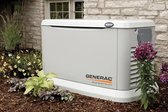
Standby generators can add value to your home and safeguard your family by keeping power running in an emergency, but this always-on protection is expensive.
The next time a storm knocks out your power — again — you may find yourself thinking about a standby generator. Unlike a portable backup generator, which you store in the garage or shed and roll out during an emergency, a standby generator is permanently installed on a gravel bed or concrete pad next to your house. If the power goes out, an electronic switch automatically signals the unit to turn on, keeping essential household systems and appliances running even if you’re miles away.
Such systems start at about $2,500 and go as high as $15,000. Always-on protection doesn’t come cheap. Here’s how to decide if it’s right for you.
When Permanent Standby Makes Sense
As with any insurance policy, when you buy a backup generator there’s no telling when, or even if, you’ll need it. Whether it’s worth the investment depends on your personal situation, your tolerance for interruptions, and your budget.
If you live in an area with frequent, prolonged outages, rely on electrically powered medical equipment, or work at home and need to stay connected, a backup generator can protect you from a disruption you may not be able to afford.
If you live where hurricanes strike, a generator safeguards family members, especially children and the elderly, against the risks of sweltering heat. If you own a second home, particularly in areas where temperatures regularly dip below freezing, it can protect your property when you’re not around. “A lot of weekenders buy standby generators,” says dealer Chris Sauer, owner of G&G Lawn and Power in Stone Ridge, New York. “It’s a lot more expensive to have your pipes freeze and flood your house than it is to buy a generator.”
If you decide the benefits are worth the cost, here’s how to proceed.
Assess Your Power Needs
Generators are sized according to wattage produced: The more watts, the bigger the unit — and the higher the price tag.
Wattage usage varies from house to house. Your generator supplier or local electrician can do a wattage assessment, or you can ballpark it yourself with an online calculator. You can also get general guidelines from national dealers such as Colorado Standby or Electric Generators Direct.
The next step is deciding what you want your generator to power. At minimum, you can run an “emergency panel” of necessities — say, a central air conditioning unit, the refrigerator, and a handful of lights and outlets. “A 17-kilowatt unit is the standard size for an emergency panel, because it has enough power for a central AC unit,” says Will Ferrigno, owner of Assurance Power in Boca Raton, Florida. If you live in a northern climate with no AC and gas heat, your emergency panel could be as small as 7kW, enough to power some lights, the fridge, and gas furnace.
At the opposite end of the spectrum is a generator with enough wattage to power your whole house. A 3,000-square-foot house with two central air conditioners, an electric range, and a whirlpool tub might require as much as 25kW to 30kW.
A third, newer option is a “load-management system,” a generator that can power everything in your house, just not all at once. Such a system could run that same 3,000-square-foot house with about 20kW, cutting power to nonessential circuits as necessary.
Related: Will You Regret Not Buying Hurricane Insurance?
Consult the Right Professionals
Most of the time, your generator supplier will also provide setup service. That’s a good option, because you know the installer will be familiar with your equipment. A less expensive way to go — and your only option if you’ve purchased the generator online — is to hire a plumber to connect the unit to its fuel source (usually propane or natural gas, though some run on diesel) and an electrician to hook it into your house’s power supply. Both should be licensed and certified for the brand of equipment you’re installing and familiar with local codes that govern such things as how close the generator can sit to the house, how big the fuel storage tank can be, and whether you need a permit.
Calculate Your Costs
Prices vary by brand and location (just try buying one in South Florida after a hurricane), but an emergency panel unit of 7kW runs $2,500 to $4,500 installed, while a mid-size 17kW unit cost $4,000 to $10,000. A large-capacity 22kW to 45kW model costs from $9,000 to $15,000.
The type of fuel also affects cost. You may need to plumb for a gas line, for instance, or purchase and install a propane tank. Diesel units come with their own tanks, but diesel fuel is expensive and needs regular treatment so that it doesn’t clog the engine over time. (Even if your generator never kicks in, it will burn about 10 gallons of fuel a year in weekly self-tests.) “Talk to your plumber and your utility company before you buy a generator to make sure you can get an affordable power source,” says Brad Corgill, a technical sales rep at Colorado Standby in Colorado Springs.
Once you’re set up, you won’t have to worry about being stuck in the dark or freezing cold again. What’s more, a standby generator can add to your home’s value, which should make you feel doubly warm all over.



